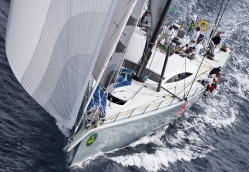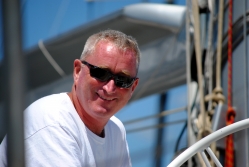|

Transatlantic Race 2011 Racing Machines Readying For Battle
Newport, R.I. USA (June 30, 2011) – Since 1866, the cornerstone of offshore yacht racing has been transatlantic races, due, in part, to legendary yachts sailed by icons of the sport. Few, however, would disagree that the impending showdown between Rambler 100 and ICAP Leopard ranks right up there with the best battles of all time.
Sunday, July 3, the third and final start for the Transatlantic Race 2011 will commence at 1350 Eastern Daylight Time, when the warning signal is fired at Castle Hill Lighthouse. Six yachts will then begin this historic and epic race across the wilds of the Atlantic Ocean. The following day as 4th of July celebrations are underway ashore, the action out on the race course is sure to be every bit as explosive.
While Rambler 100 and ICAP Leopard, sailed by George David (Hartford, Conn.) and Clarke Murphy (New York, N.Y.), respectively, are likely to contest for line honors in the Transatlantic Race 2011, the other combatants are not just filling out the numbers. The conditions will play a big part in deciding the overall class winner in IRC Class One and the victor will claim the Cape May Trophy, which James Gordon Bennett – winner of the first-ever Transatlantic Race in 1866 -- presented to the New York Yacht Club in 1872.
For Sojana, whose owner Peter Harrison (London, U.K.) is a member of New York Yacht Club, the Transatlantic Race 2011 is an opportunity to resolve unanswered questions.
“When they announced they were doing it again we were delighted to enter, because, for Sojana, it is unfinished business,” said skipper Marc Fitzgerald (Gurnard, U.K.). “We had a dramatic race in 2005. We had a medical evacuation when one of the crew broke his arm and we diverted to drop him off for surgery. We were leading our class at the time and lost 36 hours in the race. At that time we were on for the course record. Obviously we had no hesitation in getting treatment for the injured crew, but this race is unfinished business. That race was wet, windy and cold, which is not a problem on Sojana. We have hot showers, comfortable beds and proper food. If we have an advantage it will be in heavy air reaching and horrible conditions, simply because the conditions onboard the high performance race boats will be uncomfortable for their crew. We are a superyacht in with the racing yachts. We like playing with the big boys, but we are under no illusions, we are not even thinking about giving them a hard time. However, we did beat Leopard on corrected time in the RORC Caribbean 600, so it’s not impossible.”
Mark Thomas (Perth, Australia), watch captain on ICAP Leopard, gave an overview of the 100’ canting keel super maxi as final preparations were being made dockside.
“ICAP Leopard has a 47m cathedral rig,” said Thomas. “All of our mast locks are rated for 16 tons, which means the tack of the sail loads can take up to 14 tons. Leopard has got to have locking halyards – they take compression out of the rig and without them you would need to have massive halyards.”
Thomas added that the rigging is made from an exotic material called PBO and solid thermoset carbon fiber from Future Fibres. The running backstays cost roughly $8,000 each and are an essential part of trimming the sails, “however, the most important piece of equipment we have onboard is the toasted cheese sandwich machine. It will be a dark day when we run out of bread, as the rest of our rations are freeze dried.”
The young sailors on the Oakcliff All-American Offshore Team are absolutely thrilled to be taking part in this race and are reveling in the thought of crossing the start line with some of the legends of the sport. Vanquish, the Reichel Pugh 65, has two young women in crew -- Kaity Storck and Molly Robinson – who are both in their twenties.
“Although I am just 65kg there is little I can’t do on the boat,” said Storck (Huntington, N.Y.), an Inter-collegiate Sailing Association All-American. “These sails are heavy and need a group of people to drag them into place. Weight distribution is also very important. The pedestal grinders onboard are very efficient and most of the time fitness is more important than brute strength. Also, when we need the weight off the rail, if one of the lighter crew comes down to trim the main, the boat doesn’t heel over as much. I have done a lot of match racing and 470 sailing before and the basic principles are just the same. One of the big differences is that when you race inshore, if you fall out with someone you can just walk away and resolve it later. In the middle of the Atlantic that is not an option, everybody has to get along, all the time. We all take part in many different roles onboard and for me to drive a 65’ racing yacht is fantastic.”
Prior to joining the Vanquish crew Robinson (San Francisco, Calif.) was primarily crewing on 29ers. “This is a big step up for me and very different. We might be bathing in sunshine now, but we could well be heading up into the northern latitudes where it will be cold and the weather can be pretty bad. We all realize how lucky we are to be part of this program and we hope that the team will be able to carry on after this race and compete in others such as the Rolex Fastnet Race.”
The Farr 80 Beau Geste, skippered by Karl Kwok (Hong Kong), was in fine form in the Annapolis Newport Race, beating both Rambler 100 and ICAP Leopard overall after time correction. Watch captain Gavin Brady (Auckland, New Zealand) is an America’s Cup and Volvo Ocean Race veteran who has been sailing with Kwok for many years: “The ideal conditions for us will be a variety of wind angles and wind speeds. The other yachts will prefer one type of condition the whole way across. Puma, for example, is half the weight of Beau Geste and will go better in light conditions. All of the canting keel boats have dagger boards that give zero leeway and in heavy upwind conditions, that is a big advantage. Virtually all of our competitors are extreme boats, but Beau Geste was designed for a variety of wind angles and if we get upwind, downwind and reaching conditions that would be our perfect scenario. I also think that it is important to stress that this race rewards good seamanship, handling the boat well and pre-empting changes will be rewarded and that’s a good thing. The overall winner will probably be the boat that is sailed the best; we should all get the result that our performance deserves."
George David, skipper of Rambler 100, explained that his maxi yacht is a very complicated machine, and it takes a very high level of skill to sail it. “It has been a lot of fun to take a boat like this and modify it to improve it,” said David. “One of the biggest changes was to the sail plan. The forestay is now out on a bowsprit, which has increased the foot of the headsails by over four feet making the headsails 30% larger. The mainsail was reduced in size and these changes have allowed us to rebalance the boat, especially to get the bow out of the water to promote the boat onto the plane. The sprit is also designed to deflect water off the deck. In extreme conditions several tons of water can come down the deck; this affects performance and also can cause some serious problems for the crew. Green water smashing down the deck at 30 knots is not easy to work with.”
According to Tony Mutter (Auckland NZ) watch captain on PUMA Ocean Racing’s Mar Mostro, “this is a very important race for us. We will be racing with the full PUMA team and in full race mode. Time on the water is very important, as the rules for the next Volvo Ocean Race do not allow us to test with two boats, so this race will be part of our learning process with the boat. So far we have sailed about 3,000 miles in the new boat. The Transatlantic Race 2011, followed by the trip to our training camp in The Canaries will double our time on the water. We hope to get a variety of conditions to test the systems onboard and especially to look at a variety of sails. This is all extremely valuable training, but so is racing. Also with so many boats getting a head start it will give us something to go for. I don’t think we can catch them all but it will be a good motivation to push as hard as we can.”
Sponsors of the TR 2011 are Rolex, Thomson Reuters, Newport Shipyard, Perini Navi and Peters & May, with additional support by apparel sponsor Atlantis Weathergear.
For more information, visit http://www.transatlanticrace.org/.
More about the Transatlantic Race 2011
The Transatlantic Race 2011 charts a 2,975 nautical mile course from Newport, R.I., to Lizard Point, South Cornwall, England. Pre-start activities will take place at the New York Yacht Club’s Harbour Court clubhouse in Newport, while awards will be presented at the Royal Yacht Squadron’s Cowes Castle clubhouse on the Isle of Wight. Three separate starts – June 26, June 29 and July 3 – will feature 30 boats ranging from 40 to 289 feet in length. In addition to winners in seven classes (IRC Class 1 Racer, IRC Class 2 Racer, IRC Class 3 Racer/Cruiser, IRC Class 4 Racer/Cruiser, Classic, Class 40, and Open), whichever yacht finishes the course with the fastest elapsed time will set the benchmark for a new racing record from Newport to Lizard Point, to be ratified by the World Speed Sailing Council. Rolex watches will be awarded to the record holder and the overall winner (on corrected time) under IRC.
The Transatlantic Race 2011 is also the centerpiece of the Atlantic Ocean Racing Series (AORS), which includes the Pineapple Cup – Montego Bay Race, RORC Caribbean 600, the Annapolis to Newport Race, Rolex Fastnet Race, Biscay Race and the Rolex Middle Sea Race. Of the seven races in the AORS, three races, including the TR 2011 must be completed to qualify for a series victory. Each race is weighted equally in overall series scoring with the exception of TR 2011, which is weighted 1.5 times. All entered yachts are scored using their two best finishes in addition to the TR 2011. Awards for the AORS will be presented in November, 2011, at the New York Yacht Club’s Annual Awards Dinner in Manhattan.
Media Contacts:
Media Pro International, Barby MacGowan or Jan Harley, +1 401-849-0220
J2 Communications & Events (UK), Trish Jenkins, + 44 (0)1983 292576, +44 (0)7880 518689 (mobile)
Organizing Club Contacts:
New York Yacht Club, Brad Dellenbaugh, +1 (401) 845 9633); Royal Yacht Squadron, Trish Lewington, +44 (0) 1983 292191; Royal Ocean Racing Club, Ian Loffhagen, +44 (0) 207 493 2248; Storm Trysail Club, Marcy Trenholm , +1 (914) 834 8857
 |
 |
ICAP Leopard (shown here in the Rolex Middle Sea Race) will be one of the final six boats to depart in the Transatlantic Race 2011 when the starting cannon fires this Sunday, July 3. (photo credit Rolex / Kurt Arrigo). |
Sojana's skipper Marc Fitzgerald (Gurnard, U.K.) is set to resolve unfinished business from 2005 when the 115' ketch departs on the Transatlantic Race 2011. (photo credit TR2011 / Jan Harley). |
TOP
|